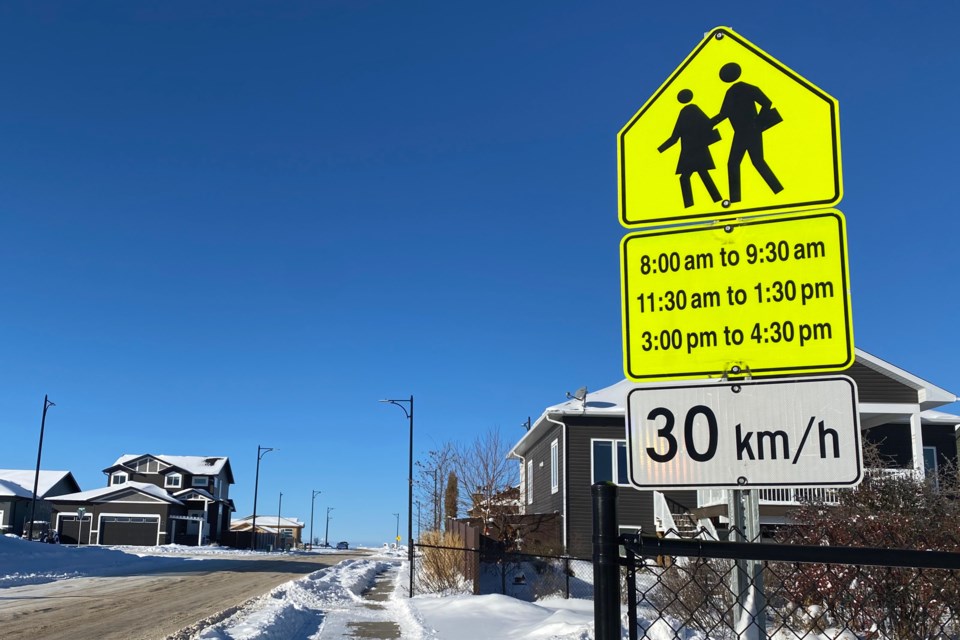OLDS — Council may soon require a couple of school zones in Olds to be converted to playground zones to increase safety for cyclists and children as well as create less confusion for drivers.
During council’s Nov. 7 policies and priorities meeting, protective services director Justin Andrew said the idea would be to change school zones at École Deer Meadow School and Holy Trinity Catholic School to playground zones.
Two councillors, James Cummings and Heather Ryan, voiced support for that suggestion.
Council voted to accept Andrew’s report as information and directed administrative staff to bring the issue back at a later date for further discussion.
Andrew said the change could be considered for Olds Elementary School (OES), as well, but it’s not considered as great a safety risk because it’s not alongside major roads, like the other two are. OES is located along 53rd Street which is a one-way street.
During his presentation, Andrew said children and residents in the area have expressed concern about the possibility that someone could get badly hurt in those areas if hit by a vehicle.
He said the advantage of converting those areas to a playground zone would be that it would be less confusing for drivers.
That’s because while lower speeds in school zones are only effect for certain hours and only when school is in session, lower speed zones in playground zones are generally in effect year ‘round every day from 7:30 a.m. until one hour after sunset.
Andrew cited results from a study that indicated that at 30 kilometres an hour, a pedestrian or cyclist hit by a vehicle has a 10 per cent chance of “succumbing to their injury," he said.
If that speed is increased to 50 kilometres an hour, he said there’s an 85 per cent chance that a person or cyclist hit by a vehicle will die.
“That is, you know, irrefutable proof that speed does equate to a more substantial negative outcome,” he said.
Andrew also noted that a survey undertaken by the Town of Olds in September indicated that a slight majority of respondents, 56.35 per cent, supported converting school zones to playground zones.
“I can honestly (say) that in my 26 years as an emergency responder here we’ve had very few impacts with children on the roadways, but the ones that we have had were substantial.
“And the question that I have to ask is that, you know, ‘is it too late when one happens?”
He listed three options for council to consider.
Option 1 was to make no change at all, keep the zones at those two schools as school zones.
"There’s no cost associated (with that option) and we can still look for more information, gather more data and see what we can come up with and hopefully come up with some positive solutions,” Andrew said.
“The risks are, of course obviously there could always be an incident or injury that then creates a reactive option for us that we feel like we have to take immediate action.”
Option 2 is to change the school zones to playground zones.
“The benefits are that we would have that enhanced protection in all of the school playground zones. There’s a lack of confusion with motorists, so that they know it’s in place all the time,” Andrew said.
"It gives enforcement the opportunity to educate drivers to make sure that they are aware that this is not seasonal or based on time of the day or time of the year or whatever.”
He conceded there’s a risk this option might not be popular with everyone – especially those who get ticketed if they’re going too fast in those areas.
“People are going to be potentially upset because they could be receiving tickets or fines for speeding in a zone when you know, they’re not occupied,” Andrew said.
Andrew said the third option would be increasing enforcement with any combination of option 1 or 2.
He said the costs of option 2 are minimal; less than $1,000, because all that would have to be done is to unscrew the school zone signs and replace them with playground signs. The sign posts could stay where they are.
He figured about 10 such signs would have to be replaced.
If council does choose to make those school zones into playground zones, the plan likely would be to make that change in early summer.
Andrew said that way, the change would coincide with the end of the school year and it would give staff lots of time to let people know that that change is coming and when it will come into effect.
He said that way, “this doesn’t just happen on a random Tuesday, if you will -- that one minute you’re driving through a school zone and had no idea and the next you’re getting a ticket for speeding in a playground zone.”
“I do wholly support option 2 of the playground zone improvement,” Cummings said.
“I think that the mandate here is clearly, at the very least, we change our school zones to playground zones. That’s a rather easy and efficient way of dealing with one issue.”
Ryan agreed.
“I do support option 2,” she said.
She noted that “in the fine print” of Andrew’s presentation that Centennial Park area is also included as a playground zone.
“I think that’s a very good idea, especially with the building of the outdoor rink there, there’ll be a lot more children downtown,” Ryan said.
"In that park, we already have a splash park there, a skate park there. I’m surprised it wasn’t identified a long time ago.”



